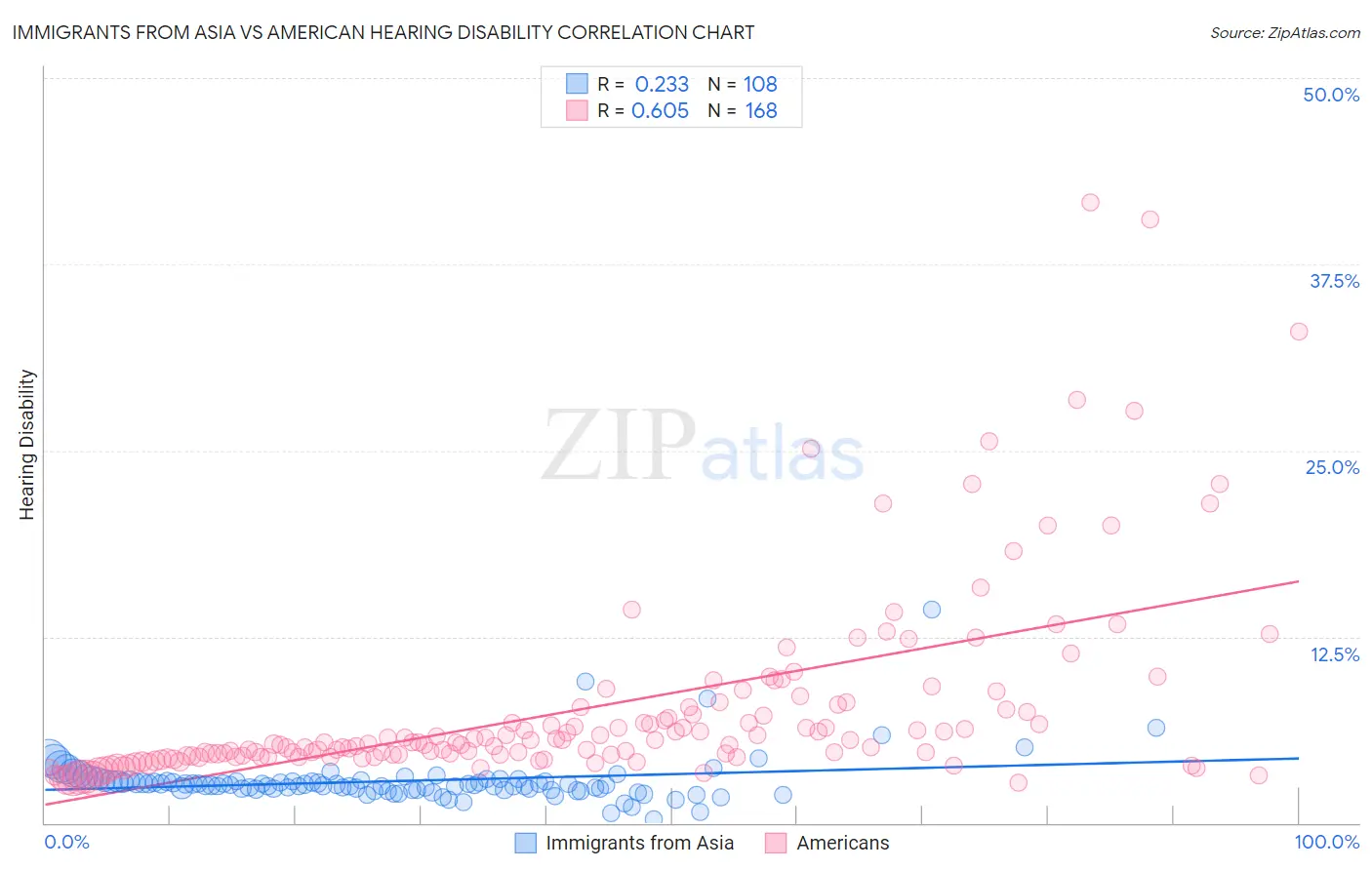Immigrants from Asia vs American Hearing Disability
COMPARE
Immigrants from Asia
American
Hearing Disability
Hearing Disability Comparison
Immigrants from Asia
Americans
2.7%
HEARING DISABILITY
97.2/ 100
METRIC RATING
80th/ 347
METRIC RANK
3.9%
HEARING DISABILITY
0.0/ 100
METRIC RATING
311th/ 347
METRIC RANK
Immigrants from Asia vs American Hearing Disability Correlation Chart
The statistical analysis conducted on geographies consisting of 548,612,138 people shows a weak positive correlation between the proportion of Immigrants from Asia and percentage of population with hearing disability in the United States with a correlation coefficient (R) of 0.233 and weighted average of 2.7%. Similarly, the statistical analysis conducted on geographies consisting of 581,034,081 people shows a significant positive correlation between the proportion of Americans and percentage of population with hearing disability in the United States with a correlation coefficient (R) of 0.605 and weighted average of 3.9%, a difference of 41.9%.

Hearing Disability Correlation Summary
| Measurement | Immigrants from Asia | American |
| Minimum | 0.21% | 2.7% |
| Maximum | 14.3% | 41.7% |
| Range | 14.1% | 38.9% |
| Mean | 2.8% | 7.7% |
| Median | 2.6% | 5.4% |
| Interquartile 25% (IQ1) | 2.2% | 4.5% |
| Interquartile 75% (IQ3) | 2.8% | 7.7% |
| Interquartile Range (IQR) | 0.58% | 3.2% |
| Standard Deviation (Sample) | 1.6% | 6.5% |
| Standard Deviation (Population) | 1.6% | 6.5% |
Similar Demographics by Hearing Disability
Demographics Similar to Immigrants from Asia by Hearing Disability
In terms of hearing disability, the demographic groups most similar to Immigrants from Asia are Immigrants from Uruguay (2.7%, a difference of 0.030%), Immigrants from Armenia (2.7%, a difference of 0.050%), Immigrants from Cuba (2.7%, a difference of 0.060%), Colombian (2.7%, a difference of 0.18%), and Mongolian (2.7%, a difference of 0.20%).
| Demographics | Rating | Rank | Hearing Disability |
| Argentineans | 97.5 /100 | #73 | Exceptional 2.7% |
| Immigrants | Korea | 97.5 /100 | #74 | Exceptional 2.7% |
| Immigrants | Saudi Arabia | 97.5 /100 | #75 | Exceptional 2.7% |
| Asians | 97.5 /100 | #76 | Exceptional 2.7% |
| Immigrants | Malaysia | 97.5 /100 | #77 | Exceptional 2.7% |
| Mongolians | 97.4 /100 | #78 | Exceptional 2.7% |
| Colombians | 97.4 /100 | #79 | Exceptional 2.7% |
| Immigrants | Asia | 97.2 /100 | #80 | Exceptional 2.7% |
| Immigrants | Uruguay | 97.2 /100 | #81 | Exceptional 2.7% |
| Immigrants | Armenia | 97.2 /100 | #82 | Exceptional 2.7% |
| Immigrants | Cuba | 97.2 /100 | #83 | Exceptional 2.7% |
| Immigrants | Argentina | 97.0 /100 | #84 | Exceptional 2.8% |
| Immigrants | Northern Africa | 96.9 /100 | #85 | Exceptional 2.8% |
| Immigrants | Iran | 96.8 /100 | #86 | Exceptional 2.8% |
| Somalis | 96.7 /100 | #87 | Exceptional 2.8% |
Demographics Similar to Americans by Hearing Disability
In terms of hearing disability, the demographic groups most similar to Americans are Cajun (3.9%, a difference of 1.1%), Hopi (3.9%, a difference of 1.2%), Cree (3.8%, a difference of 1.3%), Yakama (3.9%, a difference of 1.4%), and Puget Sound Salish (3.9%, a difference of 1.4%).
| Demographics | Rating | Rank | Hearing Disability |
| French | 0.0 /100 | #304 | Tragic 3.8% |
| English | 0.0 /100 | #305 | Tragic 3.8% |
| Marshallese | 0.0 /100 | #306 | Tragic 3.8% |
| French Canadians | 0.0 /100 | #307 | Tragic 3.8% |
| Ottawa | 0.0 /100 | #308 | Tragic 3.8% |
| Scotch-Irish | 0.0 /100 | #309 | Tragic 3.8% |
| Cree | 0.0 /100 | #310 | Tragic 3.8% |
| Americans | 0.0 /100 | #311 | Tragic 3.9% |
| Cajuns | 0.0 /100 | #312 | Tragic 3.9% |
| Hopi | 0.0 /100 | #313 | Tragic 3.9% |
| Yakama | 0.0 /100 | #314 | Tragic 3.9% |
| Puget Sound Salish | 0.0 /100 | #315 | Tragic 3.9% |
| Spanish Americans | 0.0 /100 | #316 | Tragic 4.0% |
| Comanche | 0.0 /100 | #317 | Tragic 4.0% |
| Cheyenne | 0.0 /100 | #318 | Tragic 4.0% |